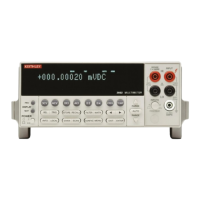Front Panel Operation
2-14
surements are specified only for the low frequency RMS
measurement type.
If a relative value is in effect when dB is selected, the value
is converted to dB. If a relative value is stored after dB units
are selected, the units of the relative value are dB.
After selecting dB, the present reference voltage level is dis-
played. To change the reference level, use the cursor keys
( and ) and the RANGE
▲
and
▼
keys. Be sure to
press ENTER after changing the reference level.
dBm:
dBm is defined as decibels above or below a 1mW ref-
erence. With a user-programmable reference impedance, the
Model 2002 reads 0dBm when the voltage needed to dissi-
pate 1mW through the reference impedance is applied. The
relationship between dBm, a reference impedance, and the
voltage is defined by the following equation:
where: V
IN
is the AC input signal.
Z
REF
is the specified reference impedance.
NOTE
Do not confuse reference impedance with
input impedance. The input impedance of
the instrument is not modified by the dBm
parameter.
If a relative value is in effect when dBm is selected, the value
is converted to dBm. If a relative value is stored after dBm
units are selected, the units of the relative value is dBm.
To set the reference impedance, perform the following steps:
After selecting dBm, the present reference impedance is
displayed (1-9999
Ω
). To change the reference impedance,
use the cursor keys ( and ) and the RANGE
▲
and
▼
keys. Be sure to press ENTER after changing the reference
impedance.
dB/dBm notes:
1. dB and dBm units are not allowed with positive or neg-
ative peak spike measurements.
2. dB and dBm units are not allowed with an advanced
filter.
3. With dB or dBm units selected, there is no bar graph or
zero-centered bar graph multiple display.
4. When units are changed from volts to dB or dBm, all
values less than zero that depend on the new units are
made equal to zero. This includes, for example, relative
values and stored readings. This avoids the overflow
condition of a log of a negative number.
COUPLING
This parameter selects the input coupling for the ACV
function.
AC:
With AC coupling selected, a DC blocking capacitor is
placed in series with the input. This removes the DC compo-
nent from the RMS, average or peak ACV measurement.
AC+DC:
When AC+DC coupling is selected, the blocking
capacitor is removed. Subsequent RMS, average or peak
ACV measurements reflect both the AC and DC components
of the signal.
While displaying readings, the present coupling setting is
shown on the bottom line, if not showing a multiple display.
Note that the coupling settings for ACV and ACI are discrete.
Thus, setting the coupling of ACV has no effect on the cou-
pling of ACI.
AC-TYPE
This parameter selects the measurement type for the ACV
function. The Model 2002 directly measures RMS, average,
and peak AC voltages. For a 330V peak-to-peak sine wave,
which is line voltage in the U.S., the measurements would
be:
• RMS = 117V
• Average = 105V (full wave rectified)
• Peak AC = 165V
The peak detector is also used to measure positive and nega-
tive peak spikes riding on a DC signal and they are, therefore,
also configured from the AC-TYPE menu.
RMS and LOW-FREQ-RMS:
Selecting between normal
RMS mode and low frequency RMS mode depends on the
desired accuracy and speed. Low frequency RMS mode is
more accurate, but slower.
Both modes are specified between 20Hz and 2MHz, with
low frequency RMS specified additionally down to 1Hz.
Some guidelines for choosing between the two modes
follow:
• Below 50Hz, use low frequency RMS mode for its
greater accuracy.
dBm
=
10
log
V
IN
2
/Z
REF
()
1mW
-----------------------------

